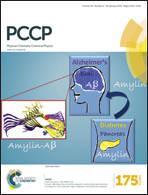Evolution of domains and grain boundaries in graphene: a kinetic Monte Carlo simulation†
Abstract
To understand the mystery of preferential mismatching angle of grain boundaries (GB) in multi-crystalline graphene observed experimentally, a systematic kinetic Monte Carlo simulation is designed to explore how a two-dimensional amorphous carbon system evolves into graphene domains and GBs. The details of the evolution, including the graphene domain nucleation, growth, rotation, coalescence, the corresponding GB motion, rotation and elimination, are observed. One hundred individual simulations with different initial configurations are performed and our simulation confirms that it is the Stone–Wales (SW) transformation that dominates the GB fast annealing process, and the results show that graphene domains with small angle GBs (<10°) tend to be annihilated but those with medium angles (>15°) tend to become large angle (≈30°), which is a consequence of the fact that the formation energies of GBs have two minima at 0° and 30°. The behavior of the formation energies is also responsible for the distribution of GBs' mismatch angles obtained by our simulations, which is very similar to those broadly observed experimentally.


 Please wait while we load your content...
Please wait while we load your content...